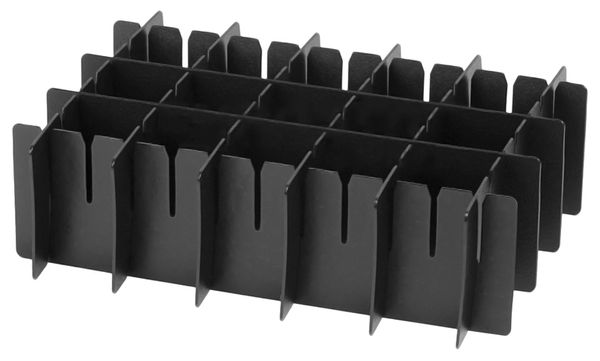The worldwide demand for ESD Dividers Market is anticipated to witness a significant growth, registering a CAGR of approximately 7.2% to 8.7% over the forecast span of 2022 to 2032. A primary catalyst propelling this growth is the increasing emphasis on the protection and preservation of delicate electronic parts and instruments, underscoring the pivotal role of the ESD dividers market.
The Electrostatic Discharge dividers market is a niche segment of the industrial packaging and storage solutions industry, specializing in products designed to protect and organize sensitive electronic components and devices. ESD dividers play a critical role in safeguarding electronic parts from electrostatic discharge, which can cause damage to the components.
Request Sample Copy of the Report: https://www.futuremarketinsights.com/reports/sample/rep-gb-9210
Key Components of the ESD Dividers Market:
- ESD-Safe Materials: ESD dividers are primarily constructed from materials that dissipate electrostatic charges, preventing static electricity buildup and discharge. Common materials include conductive plastics, carbon-filled plastics, and static-dissipative materials.
- Modular Design: ESD dividers are often modular in design, allowing users to configure and reconfigure them to create customized compartments or partitions within storage containers, bins, or trays.
- Customization: Manufacturers and users of ESD dividers require the flexibility to create compartments of various sizes and shapes to accommodate different electronic components, such as integrated circuits (ICs), microchips, resistors, and capacitors.
- Anti-Static Properties: ESD dividers have inherent anti-static properties, which are crucial for protecting sensitive electronic components during handling, transport, and storage.
- Compliance Labels: Many ESD dividers feature labels or markings that indicate their electrostatic discharge protection level and compliance with industry standards, such as ANSI/ESD S20.20 and IEC 61340.
- Durability: ESD dividers are designed to withstand the rigors of industrial environments, including resistance to chemicals, impact, and wear.
Market Dynamics and Trends:
- Electronics Manufacturing: The primary driver for the ESD dividers market is the electronics manufacturing industry, which relies on ESD-safe storage and organization solutions to protect sensitive electronic components throughout the production process.
- Stringent ESD Standards: Stringent industry standards and regulatory requirements drive the demand for ESD dividers. Compliance with standards ensures that electronic components are properly stored and protected.
- Global Supply Chain: The globalization of supply chains necessitates standardized ESD protection solutions that can be used across borders, contributing to the market’s growth.
- Technological Advancements: Advances in materials and manufacturing processes have resulted in improved ESD protection and durability of dividers. Modular designs and labeling for easy identification of components are also trends in the market.
- Customization: Manufacturers often require customized dividers to meet specific storage needs for various electronic components. The ability to create compartments of different sizes and configurations is a key market trend.
- Sustainability: Environmental concerns are leading to the use of eco-friendly materials and sustainable production processes in the manufacturing of ESD dividers.
- Market Competition: Competition among manufacturers of ESD dividers leads to innovation in terms of design, materials, and features, benefitting customers with more advanced and cost-effective solutions.
Ask an Analyst: https://www.futuremarketinsights.com/ask-the-analyst/rep-gb-9210
Regional Analysis:
- North America:
- Market Maturity: North America is a mature market for ESD dividers, driven by the well-established electronics manufacturing industry.
- Stringent Regulations: The region adheres to strict ESD control standards and regulations, such as ANSI/ESD S20.20, which mandate the use of ESD-safe storage solutions.
- Customization: Customized ESD dividers are in demand, catering to the specific requirements of manufacturers in aerospace, automotive, and semiconductor industries.
- Europe:
- Regulatory Compliance: European countries adhere to EU directives and standards for ESD control. Compliance with these regulations fuels the demand for ESD dividers.
- Innovation: European manufacturers often focus on product innovation and sustainability, leading to the development of eco-friendly ESD dividers.
- Quality and Precision: The region’s industries, such as medical devices and precision instruments, emphasize the use of high-quality ESD dividers.
- Asia-Pacific (APAC):
- Manufacturing Hub: APAC, particularly countries like China, Taiwan, South Korea, and Japan, serves as a major manufacturing hub for electronics and semiconductors. This drives substantial demand for ESD dividers.
- Cost Sensitivity: Some APAC markets prioritize cost-effective ESD solutions, which can influence product choices.
- Global Supply Chain: APAC’s role in the global electronics supply chain necessitates standardized ESD protection solutions suitable for global distribution.
- Latin America:
- Emerging Market: Latin America is an emerging market for ESD dividers, primarily driven by the growth of electronics manufacturing in countries like Mexico and Brazil.
- Regulatory Alignment: Some Latin American countries are aligning their standards with international ESD control guidelines, increasing the demand for compliant ESD dividers.
- Middle East and Africa:
- Infrastructure Investments: The Middle East’s investment in technology infrastructure and Africa’s growing electronics sector contribute to the demand for ESD dividers.
- Oil and Gas Industry: ESD dividers find applications in the oil and gas industry, where electronic components need protection in hazardous environments.
- Global Market Dynamics:
- Globalization: As businesses expand globally, the need for standardized ESD dividers that comply with international standards becomes critical.
- Technological Advancements: Advancements in materials and modular design are trends that impact the global market as innovations are adopted worldwide.
- Competitive Landscape: Competition among global and local manufacturers encourages innovation and cost-effective solutions.
Request Customization: https://www.futuremarketinsights.com/customization-available/rep-gb-9210
About Future Market Insights (FMI)
Future Market Insights, Inc. (ESOMAR certified, recipient of the Stevie Award, and a member of the Greater New York Chamber of Commerce) offers profound insights into the driving factors that are boosting demand in the market. FMI stands as the leading global provider of market intelligence, advisory services, consulting, and events for the Packaging, Food and Beverage, Consumer Technology, Healthcare, Industrial, and Chemicals markets. With a vast team of over 5000 analysts worldwide, FMI provides global, regional, and local expertise on diverse domains and industry trends across more than 110 countries.
Contact Us:
Future Market Insights Inc.
Christiana Corporate, 200 Continental Drive,
Suite 401, Newark, Delaware – 19713, USA
T: +1-845-579-5705
For Sales Enquiries: sales@futuremarketinsights.com
Website: https://www.futuremarketinsights.com
LinkedIn| Twitter| Blogs | YouTube


